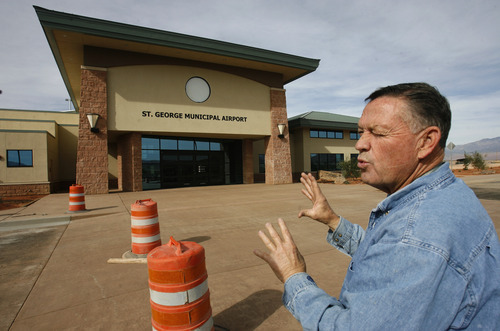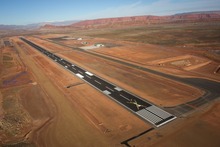This is an archived article that was published on sltrib.com in 2011, and information in the article may be outdated. It is provided only for personal research purposes and may not be reprinted.
St. George • It took a quarter-century and $159 million, but city leaders here are convinced their economy is ready to soar with a new airport projected to boost annual revenue by more than $100 million within a decade.
More than 2,000 people are expected to attend Wednesday's dedication of the airport, which sits in a wide valley surrounded by sandstone buttes.
"The possibilities are humongous here," said Mayor Dan McArthur, who has been involved from the beginning of the process to replace the current airport, which occupies a little more than 200 acres atop a bluff on the western edge of the city.
The replacement airport will allow SkyWest, the regional airline headquartered in St. George, to upgrade to Bombardier-made jets. Physical constraints of the existing airport, including limited runway length, meant SkyWest was restricted to turboprop planes, which are less popular with consumers because they are smaller and noisier.
Building a new airport from the ground up is relatively uncommon. Fred Davis, president of Tri-Star Co. in Irvine, Calif., hired to market the new airport, said the last comparable airport built from "raw land" that he knows of opened three years ago in Branson, Mo.
St. George's current airport grew from a gravel landing strip built west of the city in the 1930s on a plateau swept by fierce winds. That force of nature left many passengers with white knuckles during takeoffs and landings, another reason for the move.
The new facility has a more spacious terminal; more modern electronics for instrument landings; a longer runway that can be lengthened in the future; and more space for private hangars for general-aviation planes.
Consultants hired by the city project that, within 10 years, the annual revenue generated by the airport will grow from $19 million to $120 million. They say the increase will come not only from more flights, but from businesses expected to build on several hundred acres adjacent to the airport.
But the new airport still faces stiff competition from Las Vegas. And the economic downturn means fewer airlines are expanding, Davis said.
A survey conducted by Tri-Star of seven counties surrounding St. George in Utah, Arizona and Nevada, found that only 19 percent of the respondents use the St. George airport now. Most drive to airports in Salt Lake City or Las Vegas. But 90 percent said they would use the new airport if regional service improves.
How soon that might happen is a big question.
"Since 2001, airlines have taken such a hit in revenues that they have cut back in their planning and development, so [they] depend on communities to come to them and make a presentation on why [an airline] should serve their airport," Davis said.
Davis said his marketing plan for the new airport will focus on increasing passenger and air-cargo aviation, along with tourism-related industry. Developable acreage surrounding the airport is ideal for businesses such as aircraft maintenance, pilot training and painting services.
The Federal Aviation Administration is committed to covering $123 million of the airport's total cost from a fund fed by fees on the purchase of commercial airline tickets nationwide.
St. George is on the hook for $33 million and felt the pain when a developer stung by the economic downturn backed out of paying more than $43 million for the present airport site. McArthur said the city must find a new buyer, but in the meantime will divert $23 million in money authorized for other city projects. No property, income or sales taxes will be used to pay for the airport.
Public Works Director Larry Bulloch said the St. George airport is the only one in the country being built from scratch at the moment. When the project was officially approved for takeoff, it took the help of each of the city's 12 departments to make it happen.
"It was a leap of faith," Bulloch said.
The project was built on a fast-track schedule, which meant design and construction happened simultaneously, he said. The city hired 14 consultants to deal with issues in which it had no expertise, such as soil analysis, and signed 46 contracts for everything from grading the land to fueling rental cars. About 4.5 million cubic yards of earth had to be moved to prepare the site.
"There was nothing there, originally," Bulloch said of the site. "We had to provide access, power, gas, water and communications."
At the time construction began in 2008, the airport was projected to cost around $200 million, Bulloch said. When the economic good times ended, the cost dropped to $159 million. But that economic gain was balanced by the 30 parcels of land the city purchased for the airport when real estate prices were at a peak, he said.
"The economic times worked both for and against us," Bulloch said.
The recession wasn't the only factor that affected the airport's final price, originally pegged at $90 million. In 2001, the city was sued by environmental group Grand Canyon Trust over the potential impact of noise from jets flying over Zion National Park.
The city had already completed the required environmental assessment, but the suit argued that a more thorough environmental impact statement was needed. A U.S. District Court judge agreed, and the project was put on hold for more than five years while the document was completed and reviewed.
"We are fine with the [project now] and look forward to the airport opening," said Richard Mayol, a spokesman for Grand Canyon Trust.
Ed Wittwer, a motel manager in St. George, is excited about the new airport and even visited the construction site once to check on its progress. He said he and other businesspeople in the community are hoping more visitors will mean more business.
Wittwer is also looking forward to more-comfortable flights.
"I'm happy they're going to start using jets and no more turboprops," he said.
Airport dedication set for Wednesday
P The new St. George Municipal Airport will be dedicated Wednesday. Festivities begin with a lunch at Dixie Convention Center (registration required) then move to the airport, 4550 S. Airport Parkway, for the dedication and open house starting at 2:30 p.m. The ceremony will be broadcast live in the terminal building, on the Community Education Channel and online.
O Watch the ceremony • http://www.sgcity.org —
Replacing the St. George airport
Mid-1980s • City begins exploring need for new airport.
1995 • Consultants hired to perform environmental assessment.
1996 • Preferred site recommended.
1999 • Airport master plan completed.
2000 • Final draft of environmental assessment.
2001 • Grand Canyon Trust files lawsuit, demanding a full environmental impact statement.
2006 • Environmental impact statement completed. City gets grant for $17.2 million.
2008 • Groundbreaking for new airport.
2010 • Runway paving begins. New spur off I-15 to airport completed.
2011 • Airport begins operation.
Source: St. George City —
What it cost
Total cost • $159 million
FAA contribution • $123 million
Washington County transient room tax • $10 million
City's transportation and wastewater funds • $23 million
Stimulus funds for terminal • $3 million
Source • St. George City —
By the numbers: The new airport
Runway length • 9,300 feet, expandable to 11,500
Capacity • Can accommodate planes up to the size of a Boeing 737 or Airbus 319
Size • Built on 1,203 acres, five times larger than the current airport.
Terminal size • 35,000 square feet
Commercial space • Bordered by several thousand developable acres
Access • New Interstate 15 interchange eventually will connect with Hurricane
Growth • Room for regional carriers
Source: St. George City







